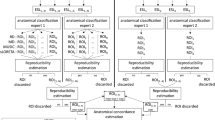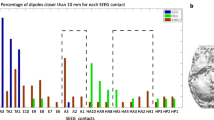Abstract
Electromagnetic source localization in electroencephalography (EEG) and magnetoencephalography (MEG) allows finding the generators of transient interictal epileptiform discharges (‘interictal spikes’). In intracerebral EEG (iEEG), oscillatory activity (above 30 Hz) has also been shown to be a marker of neuronal dysfunction. Still, the difference between networks involved in transient and oscillatory activities remains largely unknown. Our goal was thus to extract and compare the networks involved in interictal oscillations and spikes, and to compare the non-invasive results to those obtained directly within the brain. In five patients with both MEG and iEEG recordings, we computed correlation graphs across regions, for (1) interictal spikes and (2) epileptic oscillations around 30 Hz. We show that the corresponding networks can involve a widespread set of regions (average of 10 per patient), with only partial overlap (38 % of the total number of regions in MEG, 50 % in iEEG). The non-invasive results were concordant with intracerebral recordings (79 % for the spikes and 50 % for the oscillations). We compared our interictal results to iEEG ictal data. The regions labeled as seizure onset zone (SOZ) belonged to interictal networks in a large proportion of cases: 75 % (resp. 58 %) for spikes and 58 % (resp. 33 %) for oscillations in iEEG (resp. MEG). A subset of SOZ regions were detected by one type of discharges but not the other (25 % for spikes and 8 % for oscillations). Our study suggests that spike and oscillatory activities involve overlapping but distinct networks, and are complementary for presurgical mapping.






Similar content being viewed by others
References
Alarcon G, Guy CN, Binnie CD et al (1994) Intracerebral propagation of interictal activity in partial epilepsy: implications for source localisation. J Neurol Neurosurg Psychiatry 57:435–449
Auzias G, Coulon O, Brovelli A (2016) MarsAtlas: a cortical parcellation atlas for functional mapping. Hum Brain Mapp 37:1573–1592
Bagshaw AP, Jacobs J, Levan P et al (2009) Effect of sleep stage on interictal high-frequency oscillations recorded from depth macroelectrodes in patients with focal epilepsy. Epilepsia 50:617–628
Baillet S, Mosher JC, Leahy RM (2001) Electromagnetic brain mapping. Networks 18:14–30. doi:10.1109/79.962275
Bartolomei F, Chauvel P, Wendling F (2008) Epileptogenicity of brain structures in human temporal lobe epilepsy: a quantified study from intracerebral EEG. Brain 131:1818–1830
Bénar CG, Chauvière L, Bartolomei F, Wendling F (2010) Pitfalls of high-pass filtering for detecting epileptic oscillations: a technical note on “false” ripples. Clin Neurophysiol 121:301–310
Brovelli A (2012) Statistical analysis of single-trial Granger causality spectra. Comput Math Methods Med 3:10
Cosandier-Rimélé D, Merlet I, Badier JM et al (2008) The neuronal sources of EEG: modeling of simultaneous scalp and intracerebral recordings in epilepsy. Neuroimage 42:135–146
Darvas F, Pantazis D, Kucukaltun-Yildirim E, Leahy RM (2004) Mapping human brain function with MEG and EEG: methods and validation. Neuroimage 23(Suppl 1):S289–S299. doi:10.1016/j.neuroimage.2004.07.014
David O, Garnero L, Cosmelli D, Varela FJ (2002) Estimation of neural dynamics from MEG/EEG cortical current density maps: application to the reconstruction of large-scale cortical synchrony. IEEE Trans Biomed Eng 49:975–987
Deco G, Jirsa VK, Robinson PA et al (2008) The dynamic brain: from spiking neurons to neural masses and cortical fields. PLoS Comput Biol 4(8):e1000092
Delorme A, Makeig S (2004) EEGLAB: an open source toolbox for analysis of single-trial EEG dynamics including independent component analysis. J Neurosci Methods 134:9–21
Ebersole JS, Squires KC, Eliashiv SD, Smith JR (1995) Applications of magnetic source imaging in evaluation of candidates for epilepsy surgery. Neuroimaging Clin N Am 5:267–288
Gross J, Kujala J, Hamalainen M et al (2001) Dynamic imaging of coherent sources: studying neural interactions in the human brain. Proc Natl Acad Sci USA 98:694–699
Grova C, Daunizea J, Lina JM et al (2006) Evaluation of EEG localization methods using realistic simulations of interictal spikes. Neuroimage 29:734–753
Guggisberg AG, Kirsch HE, Mantle MM et al (2008) Fast oscillations associated with interictal spikes localize the epileptogenic zone in patients with partial epilepsy. Neuroimage 39:661–668
Hämäläinen MS, Ilmoniemi RJ (1994) Interpreting magnetic fields of the brain: minimum norm estimates. Med Biol Eng Comput 32:35–42
Hirai N, Uchida S, Maehara T et al (1999) Enhanced gamma (30–150 Hz) frequency in the human medial temporal lobe. Neuroscience 90:1149–1155
Horwitz B (2003) The elusive concept of brain connectivity. Neuroimage 19:466–470
Jmail N, Gavaret M, Wendling F et al (2011) A comparison of methods for separation of transient and oscillatory signals in EEG. J Neurosci Methods 199:273–289
Kaminski MJ, Blinowska KJ (1991) A new method of the description of the information flow in the brain structures. Biol Cybern 65:203–210
Kiebel SJ, Garrido MI, Moran R et al (2009) Dynamic causal modeling for EEG and MEG. Hum Brain Mapp 30:1866–1876
Lantz G, Spinelli L, Seeck M et al (2003) Propagation of interictal epileptiform activity can lead to erroneous source localizations: a 128-channel EEG mapping study. J Clin Neurophysiol 20:311–319
Larsson PG, Eeg-Olofsson O, Michel CM et al (2010) Decrease in propagation of interictal epileptiform activity after introduction of levetiracetam visualized with electric source imaging. Brain Topogr 23:269–278
Lin R, Lee RG, Tseng CL et al (2006) Multi-channel EEG recording system and study of EEG clustring method. System 18:276–283
Lina JM, Chowdhury R, Lemay E, Kobayashi E, Grova C (2011) Wavelet-based localization of oscillatory sources from magnetoencephalography data. IEEE Trans Biomed Eng 61(8):2350–2364
Mamelak AN, Lopez N, Akhtari M, Sutherling WW (2002) Magnetoencephalography-directed surgery in patients with neocortical epilepsy. J Neurosurg 97:865–873
Michel CM, Lantz G, Spinelli L et al (2004) 128-channel EEG source imaging in epilepsy: clinical yield and localization precision. J Clin Neurophysiol 21(2):71–83
Palmini A, Gambardella A, Andermann F et al (1994) Operative strategies for patients with cortical dysplastic lesions and intractable epilepsy. Epilepsia 35(Suppl 6):S57–S71
Palmini A, Gambardella A, Andermann F et al (1995) Intrinsic epileptogenicity of human dysplastic cortex as suggested by corticography and surgical results. Ann Neurol 37:476–487
Pantazis D, Nichols TE, Baillet S, Leahy RM (2003) Spatiotemporal localization of significant activation in MEG using permutation tests. Inf Process Med Imaging 18:512–523
Peled A, Geva AB, Kremen WS et al (2001) Functional connectivity and working memory in schizophrenia: an EEG study. Int J Neurosci 106:47–61. doi:10.3109/00207450109149737
Prichard D, Theiler J (1994) Generating surrogate data for time series with several simultaneously measured variables. Phys Rev Lett 73:4
Rampp S, Kaltenhäuser M, Weigel D et al (2010) MEG correlates of epileptic high gamma oscillations in invasive EEG. Epilepsia 51:1638–1642
Régis J, Bartolomei F, De Toffol B et al (2000) Gamma knife surgery for epilepsy related to hypothalamic hamartomas. Acta Neurochir Suppl 47:1343–1351
Sarvas J (1987) Basic mathematical and electromagnetic concepts of the biomagnetic inverse problem. Phys Med Biol 32:11–22
Scherg MBP (1996) New concepts of brain source imaging and localization. Electroencephalogr Clin Neurophysiol Suppl 46:127–137
Schwartz DP, Badier JM, Vignal JP et al (2003) Non-supervised spatio-temporal analysis of interictal magnetic spikes: comparison with intracerebral recordings. Clin Neurophysiol 114:438–449
Tadel F, Baillet S, Mosher JC et al (2011) Brainstorm: a user-friendly application for MEG/EEG analysis. Comput Intell Neurosci 2011:879716. doi:10.1155/2011/879716
Talairach J, Bancaud J (1973) Stereotaxic approach to epilepsy. Methodology of anatomo-functional stereotaxic investigations. Prog Neurol Surg 5:297–354
Talairach J, Bancaud J, Szikla G, Bonis A, Geier S, Vedrenne C (1974) New approach to the neurosurgery of epilepsy. Stereotaxic methodology and therapeutic results. 1. Introduction and history. Neuro-Chirurgie 20:1
Tanaka N, Hämäläinen MS, Ahlfors SP et al (2010) Propagation of epileptic spikes reconstructed from spatiotemporal magnetoencephalographic and electroencephalographic source analysis. Neuroimage 50:217–222
van Klink NE, Van’t Klooster ΜΑ, Zelmann R et al (2014) High frequency oscillations in intra-operative electrocorticography before and after epilepsy surgery. Clin Neurophysiol 125:2212–2219
Van Mierlo P, Papadopoulou M, Carrette E et al (2014) Functional brain connectivity from EEG in epilepsy: seizure prediction and epileptogenic focus localization. Neurobiology 121:19–35
Van’t Ent D, Manshanden I, Ossenblok P et al (2003) Spike cluster analysis in neocortical localization related epilepsy yields clinically significant equivalent source localization results in magnetoencephalogram (MEG). Clin Neurophysiol 114:1948–1962
Wendling F (2008) Computational models of epileptic activity: a bridge between observation and pathophysiological interpretation. Expert Rev Neurother 8:889–896
Wilke C, Worrell G, He B (2011) Graph analysis of epileptogenic networks in human partial epilepsy. Epilepsia 52:84–93
Worrell GA, Gardner AB, Stead SM et al (2008) High-frequency oscillations in human temporal lobe: simultaneous microwire and clinical macroelectrode recordings. Brain 131:928–937
Xiang J, Liu Y, Wang Y et al (2009) Frequency and spatial characteristics of high-frequency neuromagnetic signals in childhood epilepsy. Epileptic Disord 11:113–125
Zijlmans M, Jacobs J, Kahn YU et al (2011) Ictal and interictal high frequency oscillations in patients with focal epilepsy. Clin Neurophysiol 122:664–671
Acknowledgments
The authors thank Jean Marc Lina, Olivier David, Michael Scherg and Catherine Liegeois-Chauvel for useful discussions. N. Jmail was supported by an Averroes grant from the European Community and a Campus France travelling grant. The authors also wish to thank the anonymous reviewers for their useful comments. Part of this work was funded by a joint Agence Nationale de la Recherche (ANR) and Direction Génerale de l’Offre de Santé (DGOS) under grant ‘VIBRATIONS’ ANR 13 PRTS 0011 01.
Author information
Authors and Affiliations
Corresponding author
Electronic supplementary material
Below is the link to the electronic supplementary material.
10548_2016_501_MOESM1_ESM.docx
Supplementary Table 1 Regions involved in spikes and oscillations in MEG and iEEG and concordance between regions presenting network nodes
10548_2016_501_MOESM2_ESM.docx
Supplementary Table 2 List of sensor coordinates that are concordant between MEG and iEEG for spikes and oscillations in the 5 patients (when several IEEG contacts were present, only closest matches are shown).
Rights and permissions
About this article
Cite this article
Jmail, N., Gavaret, M., Bartolomei, F. et al. Comparison of Brain Networks During Interictal Oscillations and Spikes on Magnetoencephalography and Intracerebral EEG. Brain Topogr 29, 752–765 (2016). https://doi.org/10.1007/s10548-016-0501-7
Received:
Accepted:
Published:
Issue Date:
DOI: https://doi.org/10.1007/s10548-016-0501-7




